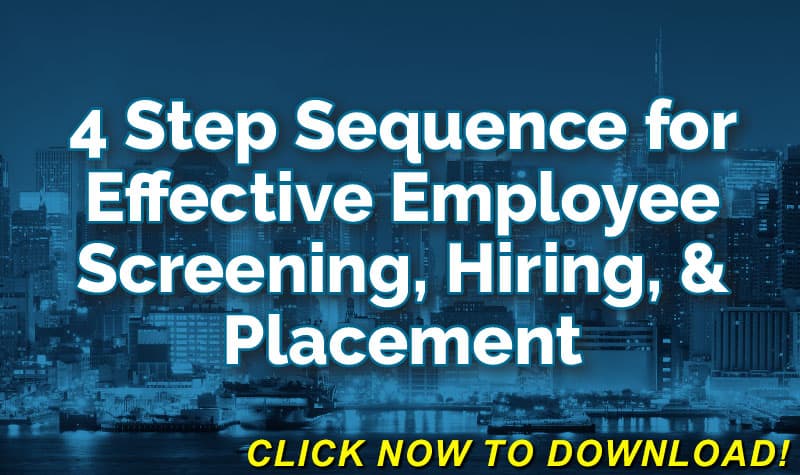
Finding qualified people to fill jobs these days can be challenging.
The unemployment rate is such that many employers take the attitude that beggars can’t be choosers, and getting butts into seats — any butts — is the only goal.
They think the idea of spending any time and money on testing applicants is a waste. But is any hire preferable to a bad hire?
This post is one in a 3-part series:
Organizations can ensure they have the right worker for the right job by taking some simple and relatively inexpensive steps to make sure their hires are free of undesirable characteristics — such as dishonesty, theft, and substance abuse; and are physically qualified to do the job.
Costs of a Bad Hire
What if you knew that at least 25 percent of job applicants would have 2x the number of injuries as other employees, and would increase your indirect workers’ compensation costs as well; in lost productivity, lost time, and retraining new workers? Does it make sense to look the other way when an applicant walks in the door?
Most companies have had a bad hire at least once; an applicant who seemed terrific, but turned out to be just the opposite. When one of these ‘bad hires’ gets injured — which they tend to do more often than ‘good hires’ — the costs can be astronomical. These costs include both direct and indirect costs, such as fewer sales, more legal issues, and increased negative morale among employees and clients.
A survey of thousands of companies by Careerbuilder found that 69 percent had been affected by a bad hire in the previous year. Of those:
- 41 percent said the cost exceeded $25,000
- 24 percent — nearly one-quarter, said they paid more than $50,000
These companies were in a rush to fill positions and faced the lack of a talent pool. Unfortunately, the amount they spent on the bad hires was substantial compared to the expense of weeding out the bad seeds before the first interview was even conducted. These companies could have saved money and time by taking some simple first steps.
Click Link to Access Free PDF Download
“4-Step Sequence For Effective Employee Screening, Hiring, & Placement”
If you posed the question to a job applicant, ‘how often did you steal from a previous employer because you didn’t think you were being paid enough?’ do you think the person who has done this would admit to it?
Surprisingly, he would! He has convinced themselves that what he has done is no big deal and, therefore, will readily admit to acting in ways that could indicate a skewed value system.
Mark Walker, VP of Business Development at Integrity First states, “The question of why someone would answer truthfully is very important, and the answer is because they suffer from a state of mind we refer to as cognitive dissonance. The individual has rationalized their bad behavior as being acceptable.”
Integrity testing, as it’s known, measures four specific behaviors:
- Substance abuse
- Hostility
- Dishonesty
- Theft
Research shows that 25 percent of people faced with integrity testing will admit to conduct that runs contrary to that of a good hire. If hired, they are more likely to incur workers’ compensation claims and have higher absenteeism and turnover, poor performances and grievances.
The time to do this testing is at the very beginning, before any time or money is spent interviewing the candidate. It gives the employer the ability to evaluate someone on their values and determine if it’s someone they want in the company. Weeding out these bad actors right from the start is key to saving an organization thousands of dollars and major headaches.
Studies show that of the remaining 75 percent of applicants, nearly all — 99 percent — will pass background and drug tests. They are less risky hires for the company
Finding Enough Applicants
One concern voiced by employers is whether they can afford to weed out 25 percent of job applicants when there are so few to start. But breaking down the math shows this to the employer’s advantage.
Walker states that an employer should ask these two questions:
- How many jobs do you plan to fill this year?
- How many applications do you typically receive on a monthly or annual basis?
Despite the low unemployment rate, most companies get more applications than they need. If, for example, the company plans to hire 1,300 in a given year and receives 2,000 applications, that still leaves 1,500 applicants who pass the integrity testing. Those remaining are less risky, more viable job applicants. They will have fewer and less costly workers’ compensation claims than bad actors.
As stated by Walker, “The question of lack of available candidates is very common, but I have not yet had a client where the number of applications was less than the number of positions that needed to be filled.”
Post-Offer Testing
Using post-offer testing to determine if a candidate is physically ready for the position and can handle the essential functions of the job is an important step.
Most injuries occur early on in a worker’s tenure, within the first year. And these injuries are often the result of the person’s inability to perform the essential functions of the job. Larry Feeler, CEO of WorkSTEPS, states, “What we’re trying to do with physical testing is just like having individuals try out for a sport, we want to make sure that each person can demonstrate they are physically capable of performing at their position.”
A job offer can be made conditionally; that is, conditioned upon her completing and passing other tests, including essential function testing. By leveraging best-in-class service providers, this is simple to do. The employer has the person replicate exactly what she will be doing day in and day out.
The tricky part of essential function testing is to determine exactly what it is the job requires for the essential elements. How much physical force must be used? How much pushing, pulling, climbing — ladders, stairs, truck door openings, etc.? Accurate, comprehensive job descriptions are imperative to conduct effective functional testing.
Feeler states, “There’s no question that the most important thing is to identify an essential vs. non-essential job task. Once job task assessments are made, then you need to test them for accuracy.”
Many employers have poor job descriptions and a poor understanding of essential and non-essential functions. It is valuable to work with a service provider to help streamline the process to create a database of thorough and accurate job descriptions.
One additional benefit of essential function testing is that it establishes the person’s baseline health and provides a comparison in the event an injury does occur. For example, the initial testing may identify a 10 percent shoulder impairment. If the person subsequently sustains a shoulder injury and is deemed to have a 12 percent impairment, the employer is responsible only for the 2 percent difference rather than the entire 12 percent impairment.
Summary
Despite the scarcity of qualified job applicants, no company wants to hire its next workers’ compensation injury, or its next thief. Employers can find suitable job candidates who will make excellent employees by taking the necessary steps before bringing them on board.

Contact: mstack@reduceyourworkerscomp.com.
Workers’ Comp Roundup Blog: https://blog.reduceyourworkerscomp.com/
©2019 Amaxx LLC. All rights reserved under International Copyright Law.
Do not use this information without independent verification. All state laws vary. You should consult with your insurance broker, attorney, or qualified professional.












